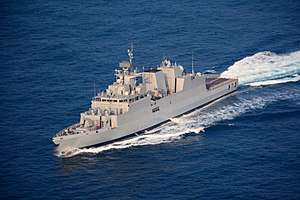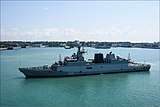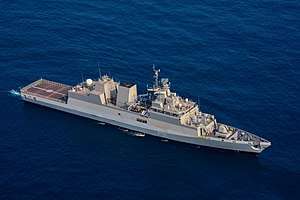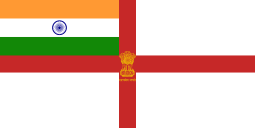Kamorta-class corvette
The Kamorta-class corvettes or Project 28 are a class of anti-submarine warfare corvettes currently in service with the Indian Navy. Built at Garden Reach Shipbuilders & Engineers (GRSE), Kolkata, they are the first anti-submarine warfare stealth corvettes to be built in India.[9] Project 28 was approved in 2003, with construction of the lead ship, INS Kamorta commencing on 12 August 2005. All of the four corvettes, INS Kamorta, INS Kadmatt, INS Kiltan and INS Kavaratti were commissioned in 2014, 2016, 2017 and 2020 respectively.
 INS Kavaratti (P31) during sea trials | |
| Class overview | |
|---|---|
| Name: | Kamorta class |
| Builders: | Garden Reach Shipbuilders and Engineers |
| Operators: |
|
| Preceded by: |
|
| Succeeded by: | Project 28A class (planned)[1] |
| Cost: | ₹7,800 crore (US$1 billion) program cost[2] |
| Planned: | 4 |
| Completed: | 4[3] |
| Active: | 4 |
| General characteristics | |
| Type: | Anti-submarine warfare corvette |
| Displacement: | 3,300 tonnes (3,200 long tons; 3,600 short tons) full load[4] |
| Length: | 109 m (358 ft)[4] |
| Beam: | 13.7 m (45 ft)[4] |
| Installed power: | 20,384 hp (15,200 kW) |
| Propulsion: | CODAD: 4 × Pielstick 12PA 6 STC6 Diesel engines[5] |
| Speed: | 25 knots (46 km/h; 29 mph)[5] |
| Range: | 3,450 nautical miles (6,000 km)[6] |
| Complement: | 193 (13 officers)[6] |
| Sensors and processing systems: | |
| Electronic warfare & decoys: | |
| Armament: |
|
| Aircraft carried: | 1 × Ka-28PL or HAL Dhruv[5] |
| Aviation facilities: | Rail-less helo traversing system and foldable hangar door[7][8] |
The platform and major internal systems of this class of corvettes are indigenously designed and built.[1] The corvettes are named after the islands in the Lakshadweep archipelago.
The Kamorta class corvettes are intended to succeed the Kora-class corvette by precedence and Abhay-class corvette by role.
Construction
The order for four Kamorta-class corvettes were placed in 2003 by the Indian Navy. Construction of the lead ship, INS Kamorta began in the year 2005 and the keel was laid down in 2006 at Garden Reach Ship Builders and Engineers, Kolkata. The ship was launched in the year 2010 and was inducted into the navy in 2014 after a series of delays.[1] Construction of the second ship in the row, INS Kadmatt followed and the keel was laid in 2007. The corvette was launched in 2011 and was inducted in the early 2016. INS Kiltan was laid down in 2010 and launched in 2013. While the last ship of its class, INS Kavaratti was laid down in 2012 and launched in 2015. Both the ships are expected to be completed by the end of 2017.[9]
The project's objective was to enhance localisation and development of warship construction industry in India. The navy asked the Indian industries to deliver equipment of higher sophistication levels than usual. This led to some unforeseen delays in the product delivery, and struggles perfecting the products.[10][11]
All the ships of this class are built using DMR 249A special grade high-tensile steel,[4] produced by the state-owned Steel Authority of India Limited (SAIL), and carbon fiber reinforced plastic (CFRP) materials. The main machinery is raft mounted, and each gear unit and its associated engines are mounted on a common raft. The diesel engines are license built by Kirloskar under SEMT Pielstick of France. DCNS supplies the noise-suppressing raft-mounted gearbox for CODAD propulsion. Wärtsilä India manufactures the low-vibration diesel alternators to power the on-board electronics.[10][12]
The ships also includes an integrated ship management system (ISMS) from L-3 MAPPS which combines an integrated platform management system and bridge management system into a single integrated system.[13]
INS Kiltan and INS Kavaratti are to be more advanced than their elder ships. In a first, composite materials, imported from Kockums, Sweden, are used for the construction of the superstructures. This resulted in increased stealth features, reduced weight relative to typical superstructures built with steel, anti-corrosive and fire resistant. It's also projected for the ships to have some additional armament and new features.[14][15][16]
Design and Description
In 2003, under the code name Project 28, the Indian Navy placed an order for four ASW corvettes. The corvette's design was originally planned to be based on the Russian corvette Project 2038.2, however the basic design was later provided by the Indian Navy's Directorate of Naval Design, followed by the detailed design by GRSE.[17] The design includes many stealth ship features, including reductions in acoustic signature and vibration of the vessels.[18]
The class incorporates some major features including but not limited to the 'X'-shaped hull form to improve stealth, a raft-mounted propulsion system to reduce vibration, and an infrared signature suppression system.[6] It also includes networks such as the Total Atmospheric Control System (TACS), Integrated Platform Management System (IPMS), Integrated Bridge System (IBS), Battle Damage Control System (BDCS) and Personnel Locator System (PLS). The ships also include technology that enables them to fight in Nuclear, Biological and Chemical (NBC) warfare scenarios. The Indian Navy claims that the indigenisation achieved in these ships is about 90%.[4]
General characteristics and propulsion
The overall length of the Kamorta-class corvettes is 109 m (358 ft), and the beam spans 13.7 m (45 ft). The ships displace about 2,500 tonnes (2,500 long tons; 2,800 short tons) at standard load and 3,500 tonnes (3,400 long tons; 3,900 short tons) when fully loaded. Each ship retains a complement of 180 sailors and 13 officers.[6]
They are propelled by four Pielstick 12 PA6 STC Diesel engines, each with a power of 5,096 hp (3,800 kW) in CODAD configuration. They also have two controllable pitch propellers which helps the ship achieve maximum speeds in excess of 25 knots (46 km/h; 29 mph).[4]
(top) BEL Revathi radar, OTO Melara 76 mm SRGM, L&T RBU-6000 ASW rocket launcher and BEL Lynx U1 fire-control radar.
Electronics and sensors
The Kamorta-class corvettes boast a wide variety of sensors. Given below are the list of known sensors in the corvette:
Armament
The armament of the class includes a license-built OTO Melara 76 mm Super Rapid Gun in a stealth mount and a weapons layout similar to what is found on the Talwar-class and Shivalik-class frigate, two Larsen & Toubro built derivatives of the RBU-6000 anti-submarine rocket launcher, as well as Larsen & Toubro torpedo tube launchers, and a pair of AK-630M close-in weapon system (CIWS). The fire-control system is the Bharat Electronics IAC Mod C system.[6]
There is an option on the ship to include surface-to-air missiles (SAM). But it is unclear as to which SAM will be integrated into the Kamorta-class corvette. Options include Barak 1 and the Barak 8.[19] The corvette can hold one helicopter, which currently is a Westland Sea King Mk.42B helicopter.[4]
Ships of the class
All the ships names of the class are reincarnations of ships from the previous Arnala-class corvette which are considered to be the spiritual predecessors of the Kamorta class.[20]
| Name | Pennant | Laid down | Launched | Commissioned | Home-port |
|---|---|---|---|---|---|
| INS Kamorta | P 28 | 20 November 2006[21]:57 | 19 April 2010[22] | 23 August 2014[23] | Visakhapatnam |
| INS Kadmatt | P 29 | 27 September 2007[21]:57 | 25 October 2011[24] | 7 January 2016[25] | |
| INS Kiltan | P 30 | 10 August 2010[26] | 26 March 2013[27] | 16 October 2017[7] | |
| INS Kavaratti | P 31 | 20 January 2012[21] | 19 May 2015[8] | February 2020 (delivered)[3] |
Gallery
 INS Kamorta entering Singapore Port.
INS Kamorta entering Singapore Port. A side view of the INS Kadmatt (P-29) of the Indian Navy at the Manila South Harbor, Philippines.
A side view of the INS Kadmatt (P-29) of the Indian Navy at the Manila South Harbor, Philippines. INS Kiltan replenishment at sea by USNS Richard E. Byrd.
INS Kiltan replenishment at sea by USNS Richard E. Byrd. INS Kavaratti during trials.jpg
INS Kavaratti during trials.jpg A side view of the INS Satpura and INS Kadmatt of the Indian Navy at the Manila South Harbor.
A side view of the INS Satpura and INS Kadmatt of the Indian Navy at the Manila South Harbor..jpg) INS Kamorta visits Kota Kinabalu, Malaysia
INS Kamorta visits Kota Kinabalu, Malaysia Kamorta-class ship undertaking sea trial.
Kamorta-class ship undertaking sea trial.
Export
Philippines Navy
Under a modernisation program, the Philippines Navy sought to purchase two light frigates, each displacing 2,000 tonnes (2,000 long tons; 2,200 short tons), spanning 109 m (358 ft) in length, capable of cruising at 25 kn (46 km/h; 29 mph) and be able to sail in sea state 7. In the bidding process, GRSE was selected as the lowest bidder among the contenders, Daewoo Shipbuilding & Marine Engineering, Hyundai Heavy Industries and Navantia. The deal was said to cost more than ₹2,157 crore (equivalent to ₹23 billion or US$326 million in 2019).[28][29] However, based on a post qualification assessment, GRSE was disqualified on the grounds of not meeting the financial capability requirements [30]
Brazilian Navy
In June 2018, GRSE submitted proposal for Brazilian Navy's Tamandaré-class future corvette program. GRSE offered a modified Kamorta class of 2,800 tonnes with weapons and sensors on par with its Philippines offer. The project was planned to be completed in Brazil's local shipyard for which GRSE teamed up with Sinergy Group Corporate for local production.[31] GRSE's proposal did not make the downselect in October 2018.[32]
See also
- List of active Indian Navy ships
- Future ships of the Indian Navy
References
- Pike, John. "Project 28 ASW Corvette". www.globalsecurity.org. Archived from the original on 8 August 2016. Retrieved 18 August 2016.
- "INS Kavaratti: Anti-submarine warfare class stealth corvette launched". The Economic Times. 19 May 2015. Archived from the original on 7 November 2016. Retrieved 18 August 2016.
- "GRSE delivers 4th anti-submarine warfare corvette to Navy". Retrieved 18 February 2020.
- "INS Kadmatt commissioned at Visakhapatnam". indiannavy.nic.in. Archived from the original on 30 August 2016. Retrieved 18 August 2016.
- Rahmat, Ridzwan; Hardy, James (22 July 2014). "Indian Navy takes delivery of first anti-submarine corvette". IHS Jane's Navy International. Archived from the original on 2 September 2014.
- Mazumdar, Mrityunjoy (6 January 2016). "Indian Navy commissions second Kamorta-class ASW corvette". IHS Jane's Navy International. Archived from the original on 9 January 2016.
- Gupta, Jayanta (16 October 2017). "INS Kiltan commissioned to Navy by defence minister Nirmala Sitharaman". The Times of India. Archived from the original on 21 February 2018.
- "'Kavaratti' – Fourth Ship of Project – 28 (Anti Submarine Warfare Corvette) Launched at GRSE, Kolkata". Press Information Bureau. 19 May 2015. Archived from the original on 21 February 2018.
- "INS Kamorta: All you need to know about India's indigenous warship". dna. 23 August 2014. Archived from the original on 24 September 2015. Retrieved 17 August 2016.
- Shukla, Ajai (1 August 2009). "Warship project delayed to build up private sector". Business Standard. Archived from the original on 31 March 2012. Retrieved 27 September 2014.
- Nair-Ghaswalla, Amrita (12 January 2018). "Strict adherence to indigenisation norm delays production of anti-sub warfare ships". The Hindu Business Line. Archived from the original on 3 March 2018. Retrieved 13 January 2018.
- "Bharat-Rakshak.com : Navy – Project 28 Class". bharat-rakshak.com. Archived from the original on 22 February 2014.
- "The Power of Two: Combined IPMS + IBS for the Indian Navy P28 Stealth Corvettes" (PDF). MCS News. June 2010. Archived from the original (PDF) on 24 December 2012. Retrieved 27 September 2014.
- "GRSE's last two ASW corvettes to be very advanced: Navy". The Times of India. Archived from the original on 12 January 2016. Retrieved 1 January 2016.
- "INS Kavaratti launched". The Times of India. Archived from the original on 20 January 2016. Retrieved 1 January 2016.
- "Navy experimenting with composite superstructure for warships". The Economic Times. PTI. 27 April 2015. Archived from the original on 3 April 2016. Retrieved 1 January 2016.
- "Project 28 ASW Corvette". globalsecurity.org. 27 February 2014. Archived from the original on 22 December 2014. Retrieved 27 September 2014.
- Malik, Amarjeet. "Anti-submarine corvette for Navy next year". Georgians News. General Military School. Archived from the original on 24 February 2015. Retrieved 27 September 2014.
- "Indian Navy test-fires missile developed with Israel". Archived from the original on 31 December 2015. Retrieved 29 December 2015.
- Shukla, Ajai (23 August 2014). "India gets its first "90 per cent indigenous" warship". Business Standard. Visakhapatnam. Archived from the original on 20 February 2018.
- "Garden Reach Shipbuilders & Engineers: Committed to Self Reliance in Maritime Security" (PDF). Garden Reach Shipbuilders & Engineers. Archived from the original (PDF) on 23 February 2017. Retrieved 20 February 2018.
- Bose, Raktima (20 April 2010). "India's first anti-submarine warfare corvette launched". The Hindu. Archived from the original on 3 March 2018.
- Subrahmanyam, G. S. (24 August 2014). "INS Kamorta joins Eastern Fleet". The Hindu. Archived from the original on 21 February 2018.
- Dutta, Ananya (26 October 2011). "INS Kadmatt launched". The Hindu. Archived from the original on 29 October 2013.
- "Boost for Indian Navy's firepower: INS Kadmatt, anti-submarine warfare corvette, commissioned". The Economic Times. 7 January 2016. Archived from the original on 21 February 2018.
- "Keel Laying – Anti Submarine Warfare Corvette GRSE Yard No. 3019" (PDF). Archived from the original (PDF) on 19 July 2011.
- Kumar, Vinay (27 March 2013). "Third anti-submarine warfare corvette launched in Kolkata". The Hindu. Archived from the original on 28 March 2013.
- "GRSE to Export Light Frigates to Philippines". DefenseNews. Retrieved 19 August 2016.
- "GRSE close to sealing deal with Philippines on warship export". Business Standard. PTI. 8 June 2016. Archived from the original on 22 August 2016. Retrieved 19 August 2016.
- "Losing bidders buck P18-b Navy deal". Manila Standard. 30 June 2016. Archived from the original on 11 November 2016. Retrieved 12 November 2016.
- "GRSE unveils design proposal for Brazilian corvette programme". Retrieved 29 June 2018.
- "Four European Designs Shortlisted for Brazilian Navy Tamandaré-class". Navy Recognition. 20 October 2018.
External links
| Wikimedia Commons has media related to Kamorta class corvette. |
- "Bharat-Rakshak.com : Navy – Project 28 Class". Bharat-Rakshak.com. Archived from the original on 22 February 2014.
- P-28 Specifications – Global Security
- Kamorta Class Analysis – Defencyclopedia




